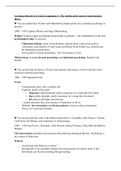Learning objectives of course component 3: The decline and return of consciousness
theory
You can explain how Witmer and Münsterberg employed the new scientific psychology in
practice.
1900 – 1950 Lightner Witmer and Hugo Münsterberg
Witmer: began to apply psychological knowledge to patients -> the establishment of the first
psychological clinic in America.
- Clinical psychology: team of psychologist, medical doctor and social workers.
Assessment: performance of tasks using instruments from Wundt (e.g. chronoscope
for measuring reaction time).
- First journal in clinical psychology: The Psychological Clinic
Münsterberg: founded forensic psychology and industrial psychology. Studied with
Wundt.
You can describe the theory of Freud, and indicate what aspects of this work have been
retained in modern psychology.
1900 – 1950 Sigmund Freud
Freud
- Consciousness plays only a modest role
- Tripartite model of the mind:
o Superego: moral principle, partly conscious, try to keep the id in check
o Ego: reality principle, partly conscious, try to keep the id in check
o Id: pleasure principle, unconscious
- > mental disorders may arise because of frustration of the id
- Methods: free association and dream analysis to discover these frustrations
- Theory isn’t relevant nowadays
You can describe the work of the behaviourists Pavlov, Thorndike, John Watson, Tolman,
Clark Hull, and Skinner, and enumerate its shortcomings.
1900 – 1950 Ivan Pavlov, Thorndike, John Watson, Edward Tolman, Clark Hull and Burrhus
Skinner
The behaviourists banished consciousness from their psychological theories. Psychology is
the science of behaviour.
Watson:
- “psychology had failed as a science.”
- Introspection is an unreliable method, but measurement of reaction times is fine
- Individuals can become anything through training
theory
You can explain how Witmer and Münsterberg employed the new scientific psychology in
practice.
1900 – 1950 Lightner Witmer and Hugo Münsterberg
Witmer: began to apply psychological knowledge to patients -> the establishment of the first
psychological clinic in America.
- Clinical psychology: team of psychologist, medical doctor and social workers.
Assessment: performance of tasks using instruments from Wundt (e.g. chronoscope
for measuring reaction time).
- First journal in clinical psychology: The Psychological Clinic
Münsterberg: founded forensic psychology and industrial psychology. Studied with
Wundt.
You can describe the theory of Freud, and indicate what aspects of this work have been
retained in modern psychology.
1900 – 1950 Sigmund Freud
Freud
- Consciousness plays only a modest role
- Tripartite model of the mind:
o Superego: moral principle, partly conscious, try to keep the id in check
o Ego: reality principle, partly conscious, try to keep the id in check
o Id: pleasure principle, unconscious
- > mental disorders may arise because of frustration of the id
- Methods: free association and dream analysis to discover these frustrations
- Theory isn’t relevant nowadays
You can describe the work of the behaviourists Pavlov, Thorndike, John Watson, Tolman,
Clark Hull, and Skinner, and enumerate its shortcomings.
1900 – 1950 Ivan Pavlov, Thorndike, John Watson, Edward Tolman, Clark Hull and Burrhus
Skinner
The behaviourists banished consciousness from their psychological theories. Psychology is
the science of behaviour.
Watson:
- “psychology had failed as a science.”
- Introspection is an unreliable method, but measurement of reaction times is fine
- Individuals can become anything through training





